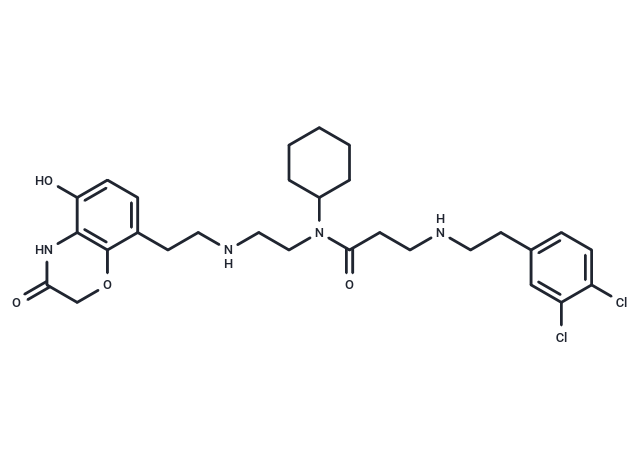Shopping Cart
Remove All Your shopping cart is currently empty
Your shopping cart is currently empty
AZ505 is an effective and specific SMYD2 inhibitor (IC50: 0.12 μM).

| Pack Size | Price | USA Warehouse | Global Warehouse | Quantity |
|---|---|---|---|---|
| 1 mg | $58 | In Stock | In Stock | |
| 5 mg | $139 | In Stock | In Stock | |
| 10 mg | $198 | In Stock | In Stock | |
| 25 mg | $328 | In Stock | In Stock | |
| 50 mg | $513 | In Stock | In Stock | |
| 100 mg | $693 | In Stock | In Stock | |
| 1 mL x 10 mM (in DMSO) | $177 | In Stock | In Stock |
| Description | AZ505 is an effective and specific SMYD2 inhibitor (IC50: 0.12 μM). |
| Targets&IC50 | SMYD2:0.12 μM |
| In vitro | The IC50 of AZ505 for SMYD2 is 0.12 μM, which is >600-fold greater than the IC50s of AZ505 for other histone methyltransferases, such as SMYD3 (IC50>83.3 μM), DOT1L (IC50>83.3 μM) and EZH2 (IC50>83.3 μM) [1]. AZ505 fails to inhibit the enzymatic activities of a panel of protein lysine methyltransferases. AZ505 is nominated for an ITC binding study with Kd of 0.5 μM. In contrast, the calculated Kd for the p53 substrate peptide is 3.7 μM [2]. |
| Kinase Assay | SMYD2 is expressed in insect cells and purified. Methylation (12 μL) reactions are carried out in TDT buffer (50 mM Tris-HCl [pH 9.0], 2 mM DTT, and 0.01% Tween 20) at room temperature using 1.25 nM SMYD2 protein, 200 nM SAM, and 100 nM biotinylated p53 peptide substrate (Biotin-aminohexanoyl-GSRAHSSHLKSKKGQSTSRH) in low volume 384-well plates. Following a 75 min incubation period, reactions are quenched by the addition of 5 μL of detection solution (20 mM HEPES [pH 7.4], 1.7 mg/mL BSA, 340 mM NaCl, 680 μM SAH, 0.04 mg/mL Streptavidin-coated AlphaScreen donor, and Protein A-coated acceptor beads), and 1 nM of a custom p53K370me1 polyclonal antibody. Reaction plates are incubated overnight in the dark at room temperature and read using an Envision 2101 Multi-label Reader. Compounds showing >50% inhibition of SMYD2 are nominated for concentration dose-response determination and are also subjected to an artifact assay. Seven compound concentrations are selected beginning at 30 μM with six half-log dilution steps. The artifact assay conditions are identical to those in the SMYD2 enzymatic activity assay, except for the absence of SMYD2 protein and the presence of 1 nM methylated p53 peptide. IC50 values are calculated from dose-response data using in-house software [2]. |
| Molecular Weight | 577.54 |
| Formula | C29H38Cl2N4O4 |
| Cas No. | 1035227-43-0 |
| Smiles | Oc1ccc(CCNCCN(C2CCCCC2)C(=O)CCNCCc2ccc(Cl)c(Cl)c2)c2OCC(=O)Nc12 |
| Relative Density. | 1.32 g/cm3 (Predicted) |
| Color | White |
| Appearance | Solid |
| Storage | Powder: -20°C for 3 years | In solvent: -80°C for 1 year | Shipping with blue ice/Shipping at ambient temperature. | |||||||||||||||||||||||||||||||||||
| Solubility Information | DMSO: 145 mg/mL (251.06 mM), Sonication is recommended. | |||||||||||||||||||||||||||||||||||
| In Vivo Formulation | 10% DMSO+40% PEG300+5% Tween 80+45% Saline: 5 mg/mL (8.66 mM), Sonication is recommended. Please add the solvents sequentially, clarifying the solution as much as possible before adding the next one. Dissolve by heating and/or sonication if necessary. Working solution is recommended to be prepared and used immediately. The formulation provided above is for reference purposes only. In vivo formulations may vary and should be modified based on specific experimental conditions. | |||||||||||||||||||||||||||||||||||
Solution Preparation Table | ||||||||||||||||||||||||||||||||||||
DMSO
| ||||||||||||||||||||||||||||||||||||
| Size | Quantity | Unit Price | Amount | Operation |
|---|

Copyright © 2015-2025 TargetMol Chemicals Inc. All Rights Reserved.